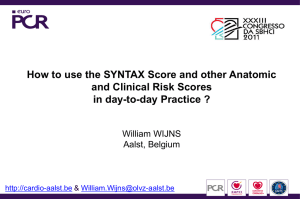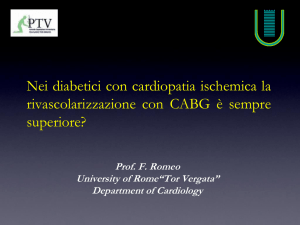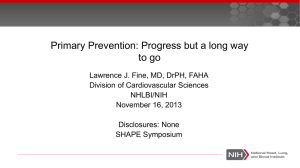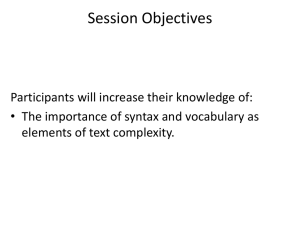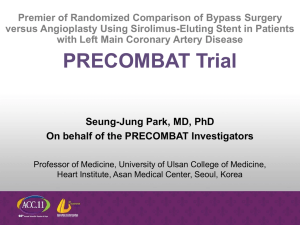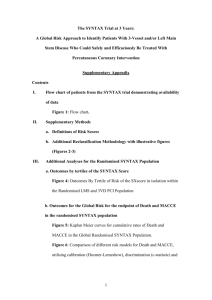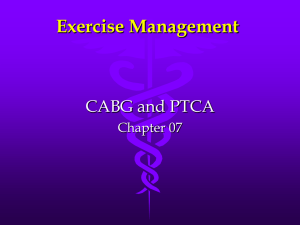The Syntax Trial
advertisement
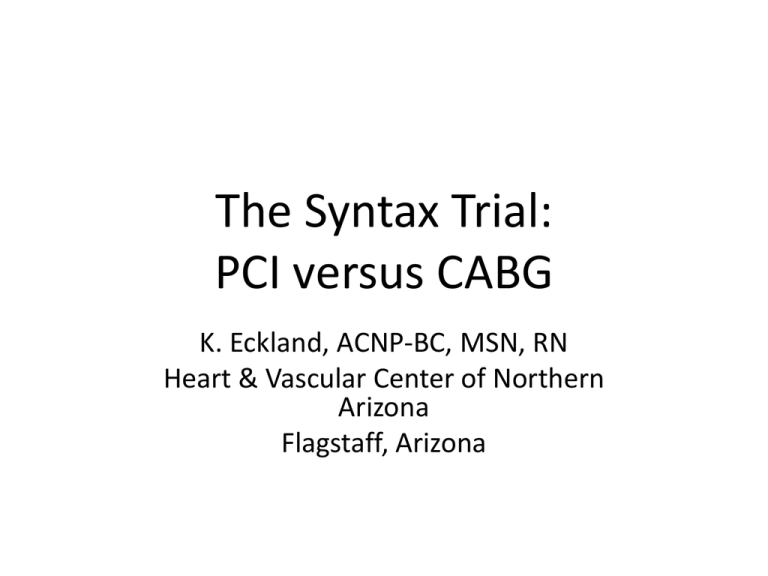
The Syntax Trial: PCI versus CABG K. Eckland, ACNP-BC, MSN, RN Heart & Vascular Center of Northern Arizona Flagstaff, Arizona 2011 was a hard year.. for cardiology.. • In the middle of this tumultuous time, the latest results from the Syntax Trial were released. The Syntax Trial • - Objectives: What is it? Purpose The syntax score(s) Considerations Results Syntax Trial • Large scale study designed by a team of cardiologists involving 1800 patients randomized to receive either PCI or CABG for multi-vessel and/or left main disease. Purpose(s) -(stated) - to determine or attempt to prove the ‘non-inferiority’ of multi-vessel stenting, and stenting of patients with left main disease versus the gold standard (CABG) -(unstated) to defend the current cardiology practices of placing multiple stents in patients who would have previously been referred for definitive treatment. Rastan, A. J. & Mohr, F. W. (2011). Editorial: Three years after SYNTAX trial – change in practice? European Journal of cardiothoracic surgery 40 (2011) 12791281. Additional Areas of Study • Comparison of results of PCI versus CABG in specific subpopulations: - Diabetics - Left main disease - ‘elderly’ patients The Syntax Score In order to compare groups of patients – (and their disease burdens), the researchers came up with a grading system which assigned a numerical value to the amount of CAD seen on cardiac cath. Syntax Score • The ‘Syntax Score’ is an overly complicated grading scheme devised by cardiologists to replace traditional criteria for stratifying patients for PCI versus surgery. • Syntax scoring attaches a numerical score to degree of blockages on cath by length, appearance and location. • This means that a ‘tight’ left main is not a tight left main – and very similar cases are not considered comparable (by this method). Syntax Score: 34 • A syntax score of ‘34’ was previously identified as the point where patients should have CABG instead of PCI in related works. • For this trial – average score was 24 for PCI, • 30 for CABG. Tight left main, bifurcation lesion, With heavy calcification Syntax score? Image taken from Sianos et. al. (2008). The Syntax Score: an angiographic tool. However… • Analysis of data showed Syntax score poor predictor of mortality and outcomes. So… The ‘Clinical Syntax Score’ (CSS) was invented (Garg et. al) Combined the Syntax Score with modified ACEF factors to create a mathematically-derived score Modified ACEF = age, ejection fraction, and creatinine clearance Garg, et al. (2010). Circ Cardiovasc Interv. 2010; 3: 317 – 326. In addition, • Questions about validity of study design/ ethics of study • Weakest of possible RCTS (versus superiority trials, and equivalence trial designs) • Non-inferior trials do NOT actually prove/ demonstrate or show non-inferiority to the comparison treatment. (ie. doesn’t really compare PCI against CABG). Mantovani et al. • In fact, superiority trials are gold standard, and are actually less expensive than ‘noninferiority’ trials. • The aim of these trials is to declare new treatment ‘acceptable’ not to show improvement over current treatments. • Trial design first used by drug companies to get permission to market new drugs. Other Considerations: Ethics • Is it ethical or even possible to consent patients for trials such as Syntax? - Side note: in your experiences with patients undergoing PCI/CABG – how well do you think they really understand the disease, outcomes, options? Ethics of Syntax • Robinson et. Al (2005) questioned the capacity of the lay public to give informed consent for experiment treatment and conducted nine different studies to explore this idea. • Specifically, they asked, “Do members of the public understand and accept randomization?” - majority of public could recognize randomization when given study designs, however – most judged that these methods were unacceptable in a trial context. Robinson et. Al. (2205) Lay public’s understanding of equipoise and randomization in randomized controlled trials. Health Technology Assessment, 2005; 9(8) Robinson et. al continued • They asked the participants if they believed that the doctors really had equipoise regarding different treatments in a study. • - about half of the participants didn’t believe that doctors could be unsure about the best treatment. • Despite augmenting standard written explanations of trials provided as part of informed consent – researchers found that the lay public could not fully understand concepts required for actual informed consent. Ethics & Syntax • Mantovani, et. al (2010) had more specific comments on the ethical behaviors of the Syntax trial. • Even title of study misleading since trial designed on a ‘non-inferiority’ margin of 6.6% This means researchers were willing to accept a 30% higher rate of death or severe adverse effects and call it “Equal”. (when in fact, equal is actual a designation higher than ‘non-inferior’.) Mantovani et. al (2010). Non-inferiority randomized trials, an issue between science and ethics: the case of the SYNTAX study. Scandinavian Cardiovascular Journal, 2010; 44:321-324. Mantovani et. al continued • Luckily? PCI patients in the trial experienced an even HIGHER rate of adverse events (otherwise study designers and proponents would be declaring victory for PCI.) Mantovani et al. “In our opinion, the Syntax study disregarded the safety of the patients, by including death and major complications of a primary endpoint of a non-inferiority study.” The Study: Results CABG SUPERIOR in all areas: LIFE Lower mortality with CABG – cardiac death only 3.6% at 3 years for CABG vs 6.0% with PCI - Less major adverse events 20.2% cabg vs 28% PCI These results confirmed previous studies. Preliminary results reported prior to 2011 as well as several other, smaller studies Results continued CABG SUPERIOR: Efficacy Patients with CABG required less re-interventions 10.7 % versus 19.7% in PCI group. - Less MIs in CABG group: 3.6% versus 7.1% (31 people vs 62 people**). - Patients with CABG reported less angina CABG relieves angina better than PCI. Family Practice News; July 12, 2009. •In CABG group – 4 pts with MI after randomization but prior to surgery, 22 occurred within 7 days of CABG. • In PCI – 2 before tx, 30 MIs within 7 days. Syntax Results: Efficacy Graft occlusion versus stent thrombosis • - 26 graft occlusions in CABG arm – 6 patients had MI, and 17 patients required revascularization. None died. • 36 patients with stent thrombosis* – 11 died. 14 patients revascularized *all but four patients in PCI group on Dual antiplatelet therapy. The Study Results CABG SUPERIOR : $$ Cost $$$ The overall costs for bypass surgery are less than the cost of PCI. The average patient randomized to the PCI arm received 4.6 stents. Among Special Populations: CABG Superior: - the treatment of left main disease - For treatment of CAD in Diabetic - For treatment of CAD in the elderly population. - Even for patients with low Syntax scores.. Syntax Trial Results Rate of peri-operative/ post-operative stroke was initially higher in CABG patients, but results equalized three years into the study with no significant different (PCI 2.0% versus 2.2% with CABG.) - This also does not take into account that in the ‘real world’, more surgeons are doing offpump surgery which reduces risk of CVA. Syntax Trial • “4-year data from the SYNTAX trial showed, a divergence in death rates between the patients who were treated with bypass surgery and those who underwent PCI with a Taxus stent. All-cause mortality and cardiac death were both significantly higher in the PCI group compared with the surgery group, as was MI, and the excess rate of strokes initially observed in the CABG group has now leveled out.” - presentation at the European Assoc of Cardiothoracic Surgery, October 25, 2011 Syntax Results As a result of these findings – new ‘revascularization guidelines’ released last week. - Collaborative work between cardiologists and cardiac surgeons. - Has recommendations for who/ when/ what circumstances people should receive PCI and when CABG is indicated. Appropriate Use Ratings for Revascularization in Acute Coronary Syndromes* American College of Cardiology Foundation Appropriate Use Criteria Task Force, et al. J Am Coll Cardiol 2012;0:j.jacc.2011.12.001v1-S0735109711050972 Copyright ©2012 American College of Cardiology Foundation. Restrictions may apply. Why this matters • The public perception of stents as the ‘easy option’ • Limited ability for public to read/ understand/ comprehend medical research.

